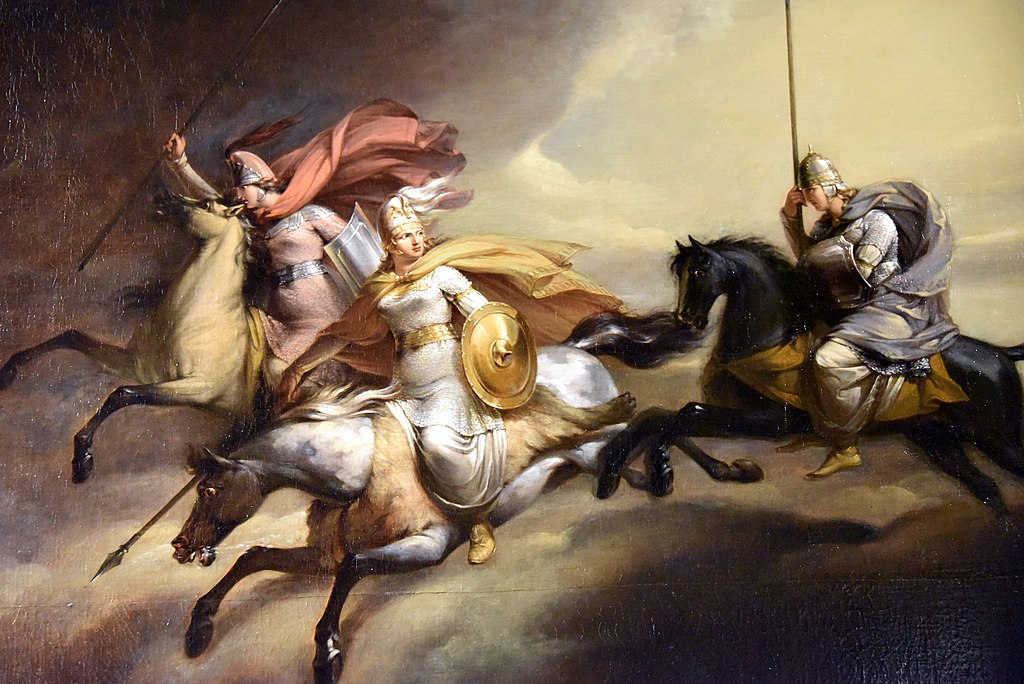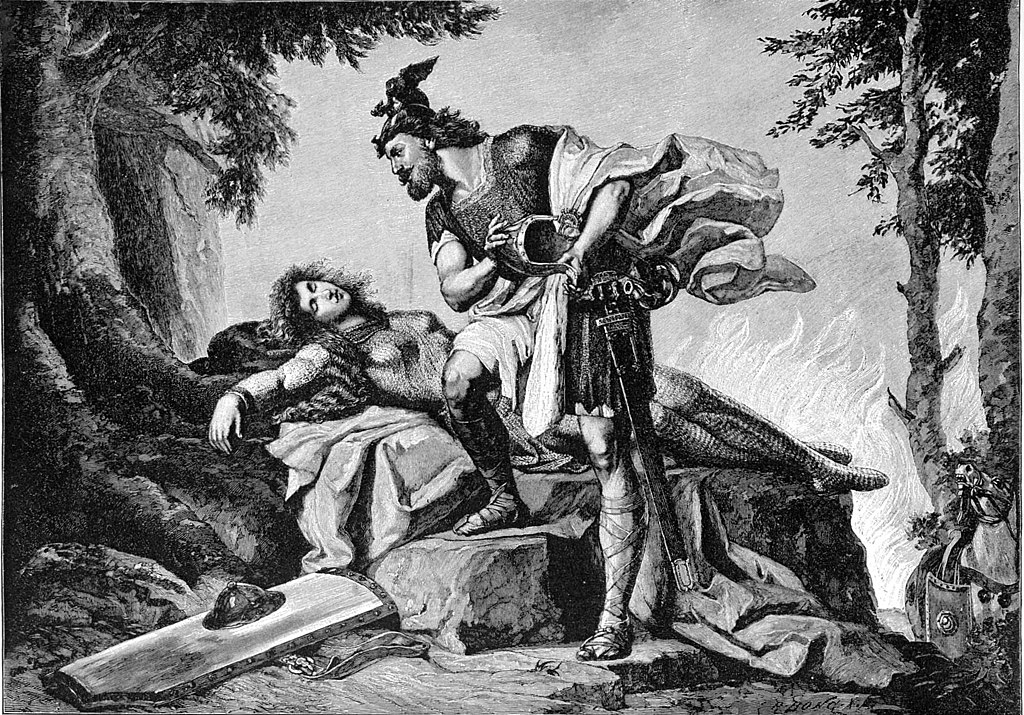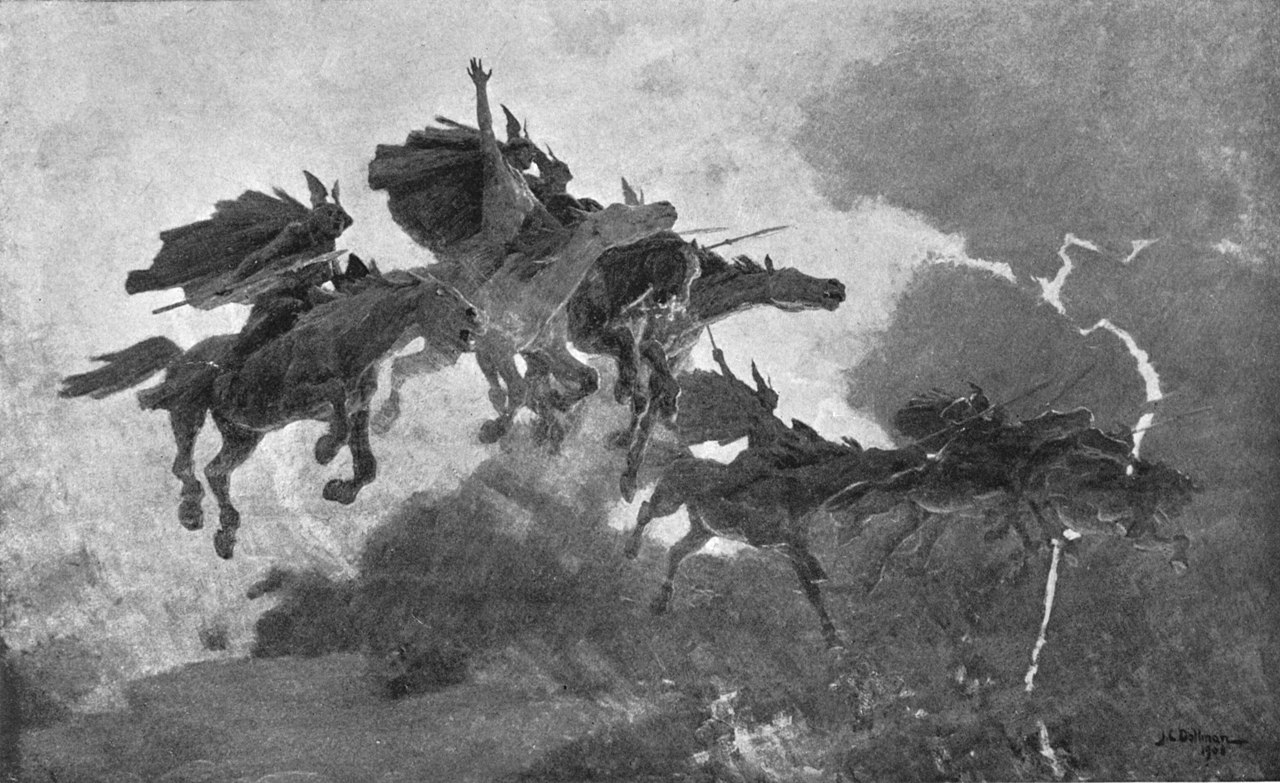Valkyries were the “choosers of the slain” in Old Nordic mythology. Always female and human or jötnar (giants), they were the god Odin’s appointed deliverers of brave warriors’ corpses to the halls of the afterlife in Valhalla.
Although Odin commanded them, the Valkyries played an essential role in selecting warriors for Valhalla. They sometimes went against Odin’s wishes when deciding whom to choose.
Who Are The Valkyries In Norse Mythology?
Valkyries (a word derived from the Old Norse Valkyrja and Valkyrjur) scoured battlefields for slain warriors and carried half to Valhalla in Asgard. The other half went to the goddess Freyja’s region of Fólkvangr.
The Old Norse Valkyrja is related to the Old English “Wælcyrġe.”
The two parts of the word Valkyrja mean “battlefield corpse” (“Val”) and “she who chooses” (“kyrja”). The most often-seen translation is “chooser of the slain.”
Valhalla and Fólkvangr were, for all intents and purposes, the same. Odin and Freyja chose from the fallen warriors, but there was no indication of who got the first pick.
Valhalla is the training ground for warriors to fight in Ragnarök, so it would make sense that the best fighters go there. However, the Valkyries are tied to Odin, the all-father, and they decide who lives and who dies.
How Are Valkyries Born?
Odin gives Valkyries their supernatural powers, but they are born ordinary mortals of human or jötunn parents.
What Are Valkyries Known For?
The Valkyries are best known for carrying warriors who died a noble death in battle to Valhalla. The maidens would sling the corpses across their horses. Once in Valhalla, the dead warriors became Einherjar and would feast and train to fight for the Æsir as part of Ragnarök.
Ragnarök was a succession of battles and events that preceded the Norse end of days. The final stage was a battle at the fields of Vígríðr that pitched the Norse gods, led by Odin, against demons and giants.
In Valhalla, the Einherjar warriors ate meat from the wild boar Sæhrímnir, which replenished itself every night and the Valkyries served them mead from the udder of the goat Heiðrún.
Becoming an Einherjar wasn’t necessarily the preserve of noble warriors. Any criminal, wrongdoer, miscreant, or low life could end up in Valhalla as an Einherjar. It was not how you lived that mattered; it was how you died.
Odin only wanted the best warriors to end up in Valhalla, so he would sometimes use the Valkyries to tip the balance of a fight in the inferior fighter’s favor so the more gifted one would die and become an Einheri (singular for Einherjar).

Are Valkyries Norse Goddesses?
No, although Odin bestowed god-like powers on them, Valkyries were not goddesses.
The possible connection between Norns and Valkyries
The Norns were a trio of giant goddesses in Old Scandinavian mythology who controlled human destiny; their names were Urðr (or Urd), Verðandi (or Verdandi), and Skuld. Urðr influenced the past, Verðandi the present, and Skuld the future.
In the Prose Edda’s Skáldskaparmál, Snorri Sturluson says the following:
Women are metaphorically called Asynjur, Valkyrs, Norns, or women of a supernatural nature.
Destiny Wyrd Urd: 3 Maidens of Norse Mythology – Mythology Source
So there may be a connection between Norns and Valkyries.
Are All Valkyries Female?
Yes, all Valkyries are essentially female.
However, Kathleen M. Self has an interesting theory about Valkyries being a kind of “third gender,” somewhere between masculinity and femininity. Valkyries and shield maidens (female Viking warriors) exhibited strong masculine characteristics, and Norse society highly regarded their fighting ability rather than any feminine qualities.
These female warriors were unique because they wore masculine armor and could select their sexual partners. However, if a shield maiden married (Valkyries never married), they “transmuted” back into their feminine roles and resorted to more typical female responsibilities like childbearing and needlework.
This change was irreversible; once married, they never returned to the “third gender.”
Who Is The Most Famous Valkyrie?
Brunhild
Brunhild (also known as Brunhilde, Brynhild or Brynhildr) is the most famous Valkyrie. There are many accounts of her exploits, and she must be one of the most attested characters in Norse mythology.
In the poem Sigrdrífumál, part of the Poetic Edda, the great warrior Sigurd (or Siegfried) traveled to the mountain of Hindarfjall, where he came across a wall of shields surrounding a sleeping woman. The woman appeared to be imprisoned in a suit of armor, so Sigurd used Gram, his magic sword, to free her.
The woman, called Sigrdrífa in this version, awoke and explained she was a Valkyrie who had refused to obey Odin on two occasions.
We find out in a different version of the story in the Völsunga saga (The saga is largely based on epic poetry of the Poetic Edda) that the Valkyrie (Brunhild in this version) had sworn an oath of loyalty to King Agnar, who was fighting a war against Hjálmgunnar. Odin ordered Brunhild to intervene on Hjálmgunnar’s, King of the Goths, behalf, but she was unable to obey due to the promise she had made to Agnar and, instead, ended up helping him.
Odin then ordered her to marry a mortal. When she refused, saying she would only marry a man who knew no fear, Odin sentenced her to imprisonment and everlasting sleep.

Sigrún
Sigrún (or “Victory Rune” in Old Norse) was another well-known Valkyrie. She appeared in the Poetic Edda in Helgakviða Hundingsbana I and II.
The hero, Helgi Hundingsbane, first met her when she was leading a group of nine Valkyries.
List of Other Known Valkyries
The total amount of Valkyries is uncertain; below is a list of 21 other known Valkyries, their names, and the meaning behind their names.
| Name | Meaning | Attestations in Norse Literature |
| Hrist | Shake | Grímnismál |
| Mist | Mist | Grímnismál |
| Skeggjǫld, or Skeggjöld | Axe age | Grímnismál |
| Skǫgul, or Skögul | Projector | Grímnismál |
| Hildr | Battle | Grímnismál |
| Þrúðr, or Thrúd | Strength (with a of supernatural strength) | Grímnismál |
| Hlǫkk, or Hlökk | Cry of an eagle | Grímnismál |
| Herfjǫtur, or Herfjötur | War fetter, or war chain, or war wife | Grímnismál |
| Gǫll, or Göll | Noise | Grímnismál |
| Geirskǫgul, or Geirskögul | Spear projector | Grímnismál |
| Randgríðr, or Randgrid | Shield eager | Grímnismál |
| Ráðgríðr, or Rádgrídr | Advice eager | Grímnismál |
| Reginleif | Divine survivor, or remnant | Grímnismál |
| Skuld | Should | Völuspá |
| Skǫgul, or Skögul | Projecter | Völuspá |
| Gunnr | Battle | Völuspá |
| Hildr | Battle | Völuspá |
| Gǫndul, Göndul | The magical one, or the monstrous one | Völuspá |
| Geirskǫgul, or Geirskögul | Spear projector | Völuspá |
| Sváva | Put to sleep | Helgakviða |
| Sigrdrífa | Victory driver (the one who makes victory happen) | Sigurðarkviða |
Who Is The Queen of The Valkyries?
Old Norse mythology regarded Freyja as a war goddess and ruler of an afterlife realm for warriors.
Britt-Mari Näsström, in her 1999 book, Freyja – The great Goddess of the North, believed that Freyja was a Valkyrie and a queen.
What Do Valkyries Symbolize?
The Valkyries symbolized victory, battle, and death to the Vikings.
What Happens To The Valkyries At Ragnarök?
It is not stated in any poems or texts what happens to the Valkyries during or after Ragnarök.
Valkyries Attestations on Old Norse Literature
We know that the Valkyries could decide who to take to Valhalla because, in the Volsung Saga, Odin condemned Brunhild to marry a mortal because she disobeyed him when she killed Hjálmgunnar, King of the Goths instead of allowing him to win in battle.
Chapter 24 of Gylfaginning, the first part of the Prose Edda by the Icelandic poet and writer Snorri Sturluson, mentions Freyja and Odin dividing the dead between them:
Fólkvangr’t is called, | where Freyja rules
Gylfaginning – Voluspa Org
Degrees of seats in the hall;
Half the kill | she keepeth each day,
And half Odin hath.
The Lay of Hákon
Further evidence that the Valkyries choose from among the dead appears in The Lay of Hákon (Hákonarmól) by Eyvind Finnsson Skáldaspillir:
Gautatýr (another alias of Odin) sent forth Gondul and Skogul [both Valkyries]
Gondul – Berloga Shop
to choose among kings’ kinsmen:
who of Yngvi’s offspring should with Óthin dwell,
and wend with him to Valholl.
However, there were occasions when Odin commanded them to fetch a worthy warrior to the “hall of the slain,” in this case, King Haakon The Good:
’Go, my Valkyries,’ Odin said,
Gondul – Pantheon Org
‘Go forth, my angels of the dead,
Gondul and Skogul, to the plain
Drenched with the battle’s bloody rain,
And to the dying Hakon tell,
Here in Valhal shall he dwell.’
And Valhalla is mentioned in a later passage but not Fólkvangr:
Sate (dying) then the liege-lords with swords brandished,
The Lay of Hakon – Sacred Texts
with shields shattered and shredded byrnies:
not happy in their hearts was that host of men,
and to Valholl wended their way.
Poetic Edda
Grímnismál
In stanzas 40 to 41, Grímnir (disguised as Odin) revealed the names of several Valkyries:
I wish that Hrist and Mist
Grimnismal – Germanic Mythology
would bring me my horn!
Skeggjöld and Skogul,
Hildr and Thrud,
Hlokk and Herfjötur,
Göll and Geirölul
Randgrid and Radgrid,
and Reginleif
they bring mead to the Einherjar.
Hrist and Mist also appeared in the following excerpt:
The Song of Grimner
May Hrist and Mist, fair ones,
Grimnismal – Germanic Mythology
Fill for me the golden goblets with wine,
While Herfiötör and other sisters ten,
With names as sweet, to happy Einheriar bear
Full bowls of sparkling sherry for their lips.
Valkyries in Wagner’s “Ring” Cycle
Though the title of the four-opera cycle is Der Ring des Nibelungen (including the famous “Ride of the Valkyries” at the beginning of Act 3), Richard Wagner used Norse mythology as his inspiration rather than the Nibelung.
Brunhild appears in the final three operas (Die Walküre, Siegfried, and Götterdämmerung) and plays a leading role in the downfall of Wotan, one of her parents.
Valkyries in the Marvel Comic Universe
John Buscema and Roy Thomas created the superhero Valkyrie in the Marvel Comic Book world. Despite her name, she is based on Brunhild.
Tessa Thompson plays “Valkyrie” in Thor: Ragnarok, Thor: Love and Thunder, and also appears in Avengers: Endgame.

